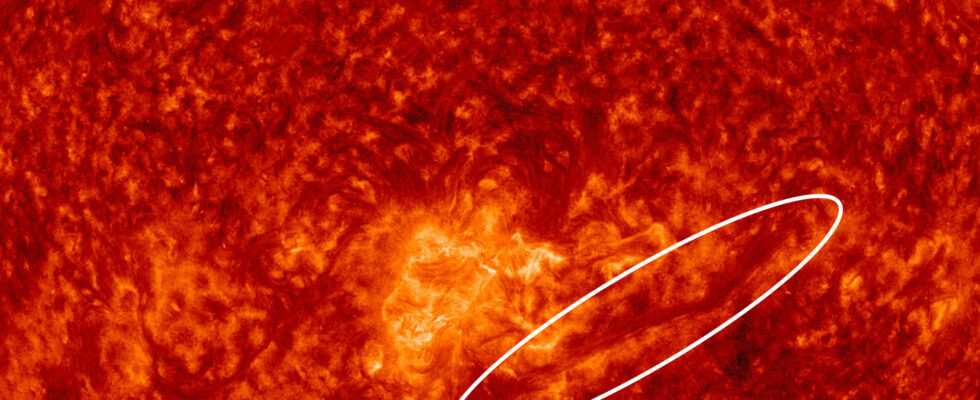The Sun has just ejected filaments on April 3 and 4, 2022. The first event is associated with the formation of a 20,000 kilometer deep “canyon of fire” on the star.
One ” canyon of fire opened on the Sun’s surface on Sunday, April 3, 2022, Space.com spotted. The phenomenon is associated with the emission of plasma filaments and the ejection of a powerful solar wind, which should promote auroras on our planet in the following days.
The measure of the “canyon” formed on the star of the solar system is estimated at least 20,000 kilometers deep, and 10 times longer. In the following images, obtained by the Solar Dynamics Observatory (SDO, a NASA satellite constantly observing the Sun), we can see the ejection and the formation of the canyon — look towards the center, slightly below law.
It can be difficult to imagine a depth of 20,000 kilometers. By way of comparison, that of the Grand Canyon in the USA reaches on average… 1.3 km. In fact, the size of the tear in the solar surface is so large that it would actually equal half the circumference of the Earth, if we “unfolded” the planet — the circumference at the equator is just over 40 000 km.
The Met Office (the national meteorological service in the United Kingdom) has confirmed on its website that two ” filament blowouts took place on the Sun, in its central part and slightly to the south. The first filament was issued on April 3 around 5 p.m. (Paris time) and the second on April 4 at 11 p.m. ” A minor/moderate G1/G2 geomagnetic storm is likely on April 6, starting with the April 3 coronal mass ejection, with a slight possibility of a strong G3 storm », comments the service.
The coronal mass ejections that accompany these eruptions are ” kinds of magnetized clouds that propagate through the interplanetary medium at speeds of up to 2,000 km/s “, describes the observatory of Paris. When a coronal mass ejection reaches Earth, it can cause a geomagnetic storm.

How intense are magnetic storms?
The Met Office rightly refers to a space weather scale established by the US Agency for Oceanic and Atmospheric Observation (NOAA), to describe the intensity of magnetic storms. We also speak of magnetic storm or geomagnetic storm to designate sudden fluctuations in the Earth’s magnetism, occurring as a result of solar flares. Thus, magnetic storms are classified into 5 groups. The following table shows the various categories in order of intensity, and the frequency of storms each time — in a solar cycle, the duration of which is estimated at 11 years.
| Ladder | Description | Possible effects | Frequency |
|---|---|---|---|
| G1 | Minor | Weak power grid fluctuations, minor impact on satellites, auroras at high latitudes. | 1,700 per solar cycle |
| G2 | Moderate | Risk of voltage problem for power systems at high altitudes, need to correct the orientation of satellites, auroras at latitudes of 55°. | 600 per cycle |
| G3 | Strong | Necessary voltage corrections on power systems, risk for satellite components and their orientation, auroras at latitudes of 50°. | 200 per cycle |
| G4 | Strict | Voltage control problems on power systems, possible loading problems on satellites, auroras at latitudes of 45°. | 100 per cycle |
| G5 | Extreme | Power outages, damaged transformers, satellite link problems, auroras at latitudes of 40°. | 4 per cycle |
This scale helps to understand that the most powerful geomagnetic storms can disrupt the links with the satellites, even the electrical networks on the ground in rarer cases. These are also phenomena that can offer magnificent spectacles of polar auroras, at more or less low latitudes.
The April 3 coronal mass ejection is expected to reach Earth this Wednesday, April 6, with a geomagnetic storm estimated at a G1 or G2 level. As for the ejection of April 4, it could reach us on April 9, causing a minor storm type G1.
